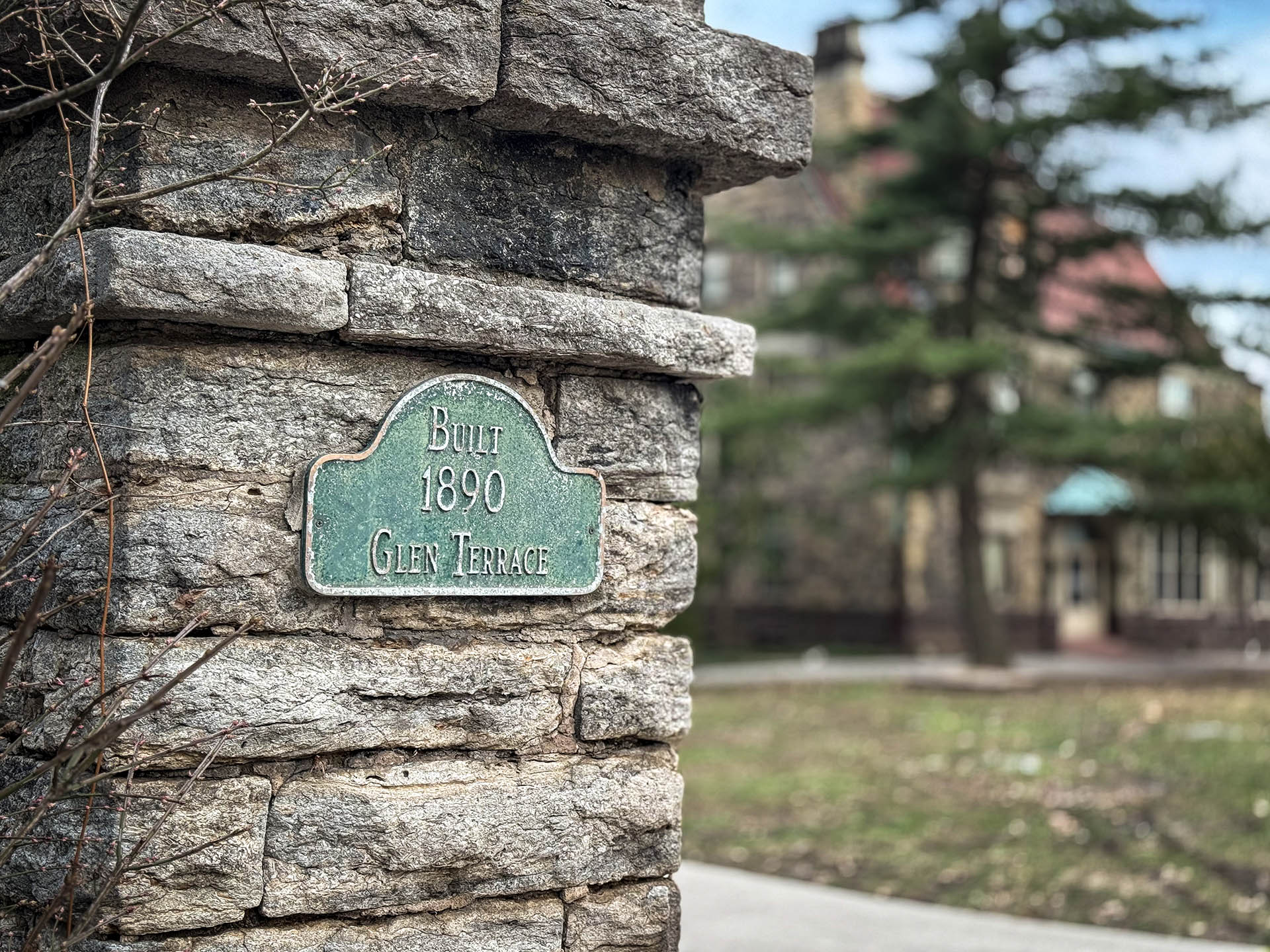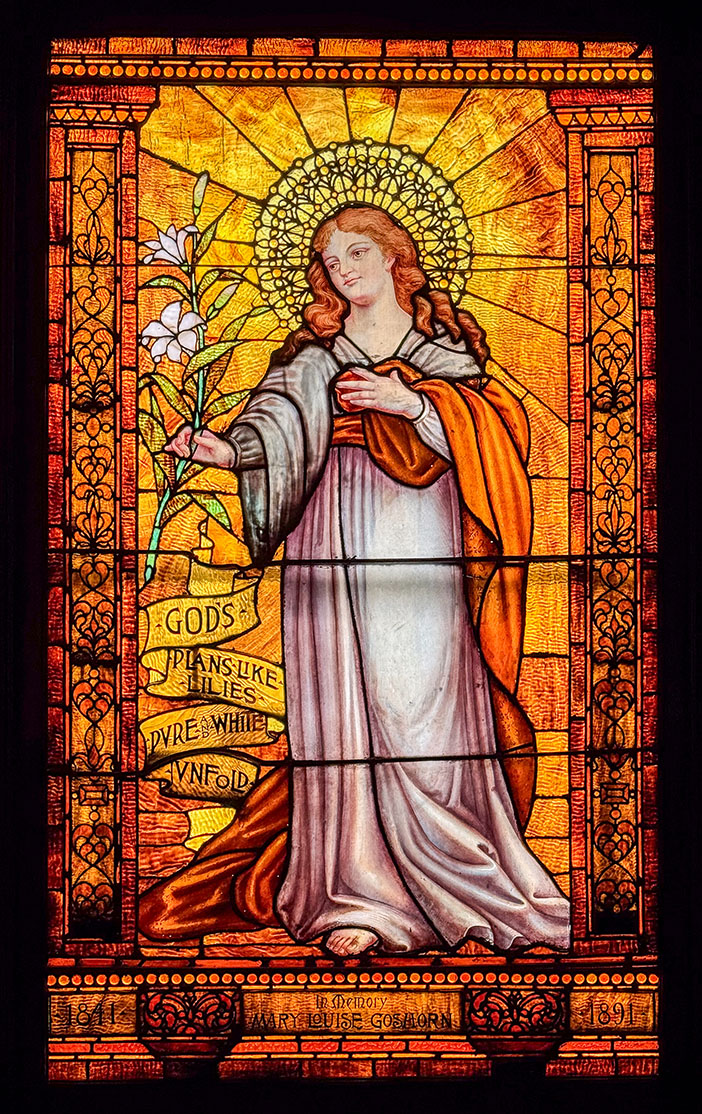
Calvary Episcopal Church is a vibrant, active church filled with people of all ages. Our building dates back to 1868 and stands as a historic presence that ties us to those people of faith who went before us and serves as a symbol of stability and hope. The window given by Sir A. T. Goshorn in memory of his wife, Mary Louise, is one such example.
On Sunday, January 29, 1888, Alfred Traber Goshorn, a vestryman of the Church, married Mary Louise (Langdon) Bugher, an “attractive Clifton widow” and church member. After a long engagement, no invitations had been sent, but word of the event spread throughout the village. When the bride and groom appeared at the church at 4pm, it was completely filled with their friends. In the words of a Cincinnati Enquirer reporter, “it would be difficult to find two more popular people in society, or two more perfectly suited to each other in all respects. The wooing had been a long one, and all true lovers, married or single, will rejoice at the happy conclusion yesterday at the altar of Calvary of as pretty a romance as ever graced the pages of a novel.“
Sadly, less than four years later, Mary died on December 5, 1891, in New York. Her remains were returned to Cincinnati, where they were interred at the Spring Grove Cemetery. In memory of his wife, Goshorn commissioned a stained-glass window from Alfred Vollmer of the Decorative Art Company of Cincinnati, which was installed at Calvary Church in late November 1892. The Cincinnati Enquirer marked the event, stating the window’s “background consists of amber glass varied from a quite light to a rich golden brown color, enriched by the rough texture of cathedral glass. In the center is a female figure standing, holding forth in the right hand some white lilies. To one side is the legend: ‘God’s plans, like lilies pure and white, unfold.’” The warm brown colors were reminiscent of Mary’s own bridal wardrobe, which was described as a “plain brown cloth traveling suit, with a becoming chapeau of brown.”
Marie Louise Langdon was born on August 23, 1841, to Solomon and Martha (Perin) Langdon in Cincinnati. The Langdon family were early settlers in Hamilton County, Ohio. She married Captain Aaron H. Bugher, originally from Fayette County, Pennsylvania, on April 26, 1864. On Bugher’s death on October 20, 1876, it was reported that she inherited his “vast fortune” and remained a widow until she married Goshorn in 1888. At the time of her death, she was a manager of the Widows’ Home and interested in many charitable undertakings.
Sir Alfred Traber Goshorn (July 15, 1833 – 1902) was a prominent businessman and civic leader in Cincinnati, Ohio, particularly in the Clifton neighborhood. He initially practiced law after earning his degree in 1857 but later transitioned into business, becoming vice president of the Anchor White Lead Company. He played a pivotal role in the early development of baseball in Cincinnati. In 1866, he became the first president of the Cincinnati Base Ball Club, which later evolved into the Cincinnati Red Stockings, recognized as the country’s first professional baseball team. Beyond sports, Goshorn was instrumental in organizing industrial exhibitions. He directed the 1870 Cincinnati Industrial Exposition and served as the director-general of the 1876 Centennial Exposition in Philadelphia, the first World’s Fair in the United States. His leadership earned him international accolades, including a knighthood from Queen Victoria.
After the Women’s Art Museum Association (WAMA) pushed for an art museum in Cincinnati, Goshorn became a major advocate for the project. He served as the museum’s first director from 1881 to 1902, overseeing its early acquisitions, exhibitions, and growth. The Cincinnati Art Museum was officially founded in 1881 and opened in 1886 in Eden Park. The museum’s building was designed by James W. McLaughlin, one of Cincinnati’s leading architects. The early collection featured European and American paintings, sculptures, and decorative arts, many acquired with Goshorn’s influence.
In 1888, after their marriage, Goshorn commissioned the same architect James W. McLaughlin to design their new residence, known as “Glen Terrace,” at 3540 Clifton Avenue. The Decorative Art Company, of Cincinnati, was engaged to decorate the home. The house was listed on the National Register of Historic Places in 1973 due to its architectural significance.
The Decorative Art Company, of Cincinnati, established a solid reputation for decorating the interiors of public buildings, hotels and private residences in the late 19th century. It was also known for creating beautiful stained-glass windows. As of 1892, it was reported that the company had decorated the St. Nicholas Hotel in downtown Cincinnati and was in line to decorate the new Palace Hotel in Denver, Colorado, and redecorate the Tabor Grand Hotel in the same city. The company also decorated Goshorn’s home on Clifton Avenue and designed and installed the stained-glass window at Calvary Church in memorial to Mary Louise Goshorn. The company was hard hit by the financial Panic of 1893 (1893–1897) and ceased operations in 1896. (The Panic was triggered by railroad bankruptcies, a run on gold reserves, and financial instability. It led to high unemployment and widespread business failures.)
Today Calvary Church is a community where members find their place in the mission and ministry of the church, much as it was for Alfred and Mary Goshorn in the late 19th century. We continue to serve, worship, pray, celebrate and bereave in this place, surrounded by saints of the past and present.
Dan Young
(Thank you to Howard Helvey for providing photos)

